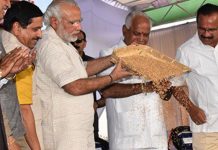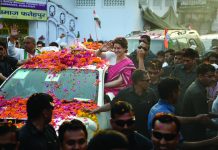[cycloneslider id=”darkness”]
Stephanie is leaving India. She has had enough. “I want to live here,” she says, “but how can I?” Stephanie is from Cameroon, one of tens of thousands of African nationals — there are no official records of the exact numbers — living in Delhi. Most come to India to study, some to trade, some, like Stephanie, to start their own business. Ask her why she came to India, she acidly remarks that it was a “land of opportunity”. As an African living in India, she is all too familiar living with the constant stares, the frequent name-calling, the occasional copped feel, the stereotype of drug-peddling cannibal. All of that angers her, but it is a darker side of our society’s racism that has precipitated her reluctant departure.
Stephanie is not her real name. She asks me on our first meeting not to reveal it because she doesn’t want any more trouble from the police or the government. She is leaving because of the targeted violence against Africans in Khirki Village in Delhi, where she lives and runs a ‘kitchen’, an illicit drinking establishment frequented by Africans living nearby. A year ago, her bar was vandalised by a mob. She had complained to the police, but nobody has been arrested since. She picked up and moved to a second site and restarted the ‘kitchen’ there. Last month, her cousin was brutally assaulted. That was the last straw.
A watchman, who was one of the eyewitnesses to the incident, remembers that on night of 18 October, the 34-year-old woman was walking alone on Press Enclave Road, which separates the urban village of Khirki from the swanky malls of Saket. As she passed two youths, one of them felt her up. She stopped and confronted them. The watchman, meanwhile, rushed to her aid. “I grabbed one of them by the collar and dialled the police,” he says. “The other ran away.” Before the police could arrive, however, a group of around 20 men gathered and attacked the woman, leaving her badly bruised.
A month has gone by since the attack, the woman’s wounds have begun to heal, but any hope for justice eludes Stephanie and her cousin. This is by no means an isolated incident; there have been recurring cases of such violence in Khirki and neighbouring Hauz Rani, where faceless mobs attack solitary Africans, says Aastha Chauhan, a community artist who has worked in Khirki, especially with its African population, for years. Last week, a young Nigerian child was stoned as he walked home from school. A couple of weeks before that, Chauhan witnessed another molestation attempt on a girl from the Northeast. “She looked back but didn’t say anything,” she says. “I was going to react on her behalf, but then they tried the same thing with me. I fought back, and eventually some boys came and separated them from me. They [the assailants] told me that this is what happens when you help Africans.” Chauhan alleges that the police rarely acts when Africans complain about such attacks.
It is an attitude borne out by Malviya Nagar Police Station SHO Vijay Pal, who dismisses any talk of attacks against Africans, saying that the biggest problem in Khirki is theft. Pal doesn’t know how many Africans live in the village, which falls under his jurisdiction, responding to a question by saying that “we have deported around 50 to 100 of them”. After similarly rebuffing other questions, he explains what the problem really is. “You see, all these Africans open kitchens, where they sell alcohol without a permit. They party all night, which disturbs the other residents. That’s all.”
Talk to the residents, and you hear similar opinions being bandied about. The Africans drink, they say, they deal in drugs, they indulge in prostitution. The attacks, they imply, are a reaction to these crimes. “The thing is, earlier there were very few of them,” says Aditya Kaushik, a local builder. “Now their numbers have increased drastically. In the attackers’ eyes, all Africans are Nigerians, which isn’t true. There are Congolese, Somalians, Utopians [he presumably means Ethiopians], Ugandans… But they have spoiled the local atmosphere. It’s fine if they’re going to carry out illicit activities quietly, but they cause a racket at odd hours. They’ve turned Select Citywalk [one of the malls in Saket] into a red-light area.” Crime, he says, citing his experience of dealing with Africans for years, is “in their blood”.
Notwithstanding his strong words, Kaushik is one of the few in Khirki, and in Delhi, who is willing to rent rooms to Africans. He has been doing so for the past five years. Others either refuse or charge double, sometimes three times, the usual rent. The large numbers of Africans living in places like Khirki is a consequence of the fact that they find it extremely difficult to find decent accommodation elsewhere. Large number of Africans involved in crime, similarly, is a consequence of the fact that they find it extremely difficult to find decent jobs. Both these conditions exist because of a pervasive suspicion among Indians for Africans, precipitating a vicious cycle of discrimination and crime. With time, they have developed internal support structures that allow new immigrants to find jobs and housing, which has, in turn, caused the concentration of the African population into a few colonies.
The bar, Stephanie says, is an integral part of (non-Islamic) African cultures, a place where people congregate at the end of a hard day’s work to unwind, meet friends, share stories. Stephanie acknowledges it can get loud, but never unruly. There are no cases, she insists, of patrons of her bar getting violent either with each other or with locals. She also acknowledges that the crimes the residents accuse the Africans of exist, that there is prostitution and drug dealing among the community. “But isn’t there prostitution among Indians?” she counters. And aren’t drugs and women, a friend pitches in, being sold to Indians? Everyone knows, Stephanie says, exactly where prostitution happens, but no one stops it. Instead, the targets of mob fury are mostly innocents making their way home. The police, many residents — both Indian and African — allege, is only interested in people who overstay their visa or the owners of speakeasies, not in protecting those who face violence. In a plea to Delhi police commissioner BS Bassi for better, more sensitive policing in the area in the wake on the attack on Stephanie’s cousin, Chauhan writes that “local hooligans” take advantage of the situation to target anyone and everyone. “They steal, molest and rape under the pretext that it is the black man causing the commotion, an excuse everyone is willing to buy. Negligence, ignorance and apathy displayed by the local police is going to turn Khirki into a ghetto.”
The next step to such stereotyping by local residents and police was made abundantly clear in Goa in the days following 30 October. On that day, a Nigerian was found murdered near Parra. An inland village north of Panjim and close to the busiest beaches in the state, Parra is, like others of its kind, sought for its cheap rents. It has a sizeable West African population, one of the largest in the state. Like with every ethnicity in this tourist state, a portion of that population is involved in flourishing drug trade. A majority are students in government, private or pastoral institutions.
There is no definitive evidence that Obodo Uzoma Simon, the victim of what was a vicious assault by a large group, was involved in the drug trade. It is entirely possible, and further investigation might establish that he was. But the newspapers would report it the next day itself as a “gang war”. The Nigerians of Parra were used to such instant assumptions, and bitter about a history of harassment by the police, who are far quicker to suspect than protect them. When the police arrived in Parra to collect the body for autopsy, a group of Nigerians refused to hand it over, demanding that the police arrest the assailants first.
The next day, after the police managed to collect the body, the hearse was stopped by a group of around 50 West Africans, mostly Nigerians. They placed Simon’s body on the road and blocked NH 17, the arterial north-south road in the state. They demanded an impartial investigation, and that Nigerian High Commissioner Ndubuisi Vitus come to the spot. Their protest lasted for about half an hour, after which all of them were rounded up and taken to the police station. Meanwhile, three others, who were late for the protest, ran into a group of locals — “not so much upset locals, but members of rival gangs,” claims Jason Keith Fernandes, an activist who has written about the issue for DNA— who beat them to within an inch of their lives.
Bizarrely, the lynching of these three Nigerians was welcomed in Goa, where many believed that it was an appropriate retaliation for the nuisance caused by Nigerians, both on the highway as well as their alleged involvement in the drug trade. The protesters were vilified. “Good and quality tourists would not like to visit Goa after seeing this,” said state Arts and Culture Minister Dayanand Mandrekar. “Nigerians are like cancer.” Rajya Sabha MP from Goa, Shantaram Naik claimed that “Nigerians misuse education schemes, violate the Foreign Exchange Management Act (FEMA), indulge in drug trade and yet try to boss over Goans, which no civilised society would tolerate”. Chief Minister Manohar Parrikar told reporters that he had asked the police department to comb the state for Nigerians residing illegally and deport them.
Suddenly, Nigerians and, by extension, other Africans, were no longer welcome in Goa. The Parra panchayat resolved to stop letting out rooms to Nigerians. In ways large and small, they were excluded from Goan society: a village refused to allow African residents to play at the local football field, the nightclubs of Baga beach refused entry to all Africans. Meanwhile, a comment by Jacob Nwadibia, an administrative attaché at the Nigerian High Commission in Delhi, expressing concern over repercussions faced by the over 1 million Indians living in Nigeria (as opposed to 50,000 Nigerians in India) was construed as a threat by one sovereign nation to another. Images of Idi Amin were quick to follow; one news channel demanded to know who Nigeria was to threaten India.
“The black figure is a figure of fear,” says Fernandes. “If you are told that 100 to 200 Nigerians [as was reported by various media] are holding up the road, you will demand the arrest of these savages.” He has extreme reservations about the coverage of the incident, saying that the African protesters were unfairly demonised by the political class in order to distract from the close relationship between the public drug trade and local politics. Speaking to a television channel on the incident, activist Oscar Rebello was more blunt. “We need to understand fundamental economical questions. Here, the biggest problem is that the drug trade of the coastal belt runs the political economy of the coastal belt. Period.” Whether or not Simon or the ones around him were involved in some narcotics gang, the fact remains that there is now an impression created that rather than being one of sundry players in a complex attritional struggle to control the trade in the state, West Africans are the primary source of all that’s wrong with law and order in Goa.
“Incidents of mob lynching,” author and activist Amita Kanekar writes in The Navhind Times, “are often presented as spontaneous eruptions of anger against an ineffective government, but are, in fact, almost never so. Usually the manifestation of a shared local sentiment against a weaker opponent, they tend to happen only when it is convenient and ‘safe’ to take the law into one’s own hands… Lynching is never directed at the powerful but at the powerless.” There are a number of theories that can, and have, been floated to explain Goa’s sudden racism. The unique circumstances of its history mean that Goan identity is central to the state’s worldview. Africans are only the latest in a series of ‘outsiders’ who have been viewed with suspicion and distrust in the state. With the construction boom, migrant labourers from neighbouring states — known as ghantis — were identified as the state’s biggest problem. With the explosion of the tourism industry, foreigners have been accused of corrupting the state’s morals, though there has always been a clear distinction since the days of the hippies between rich and poor foreigners.
But the actions of the crowd that assaulted the three Nigerians taps into a primal urge that is more universal than a state’s insecurities. The similarities with what is happening, albeit in a more deliberate, shadowy manner, in Khirki, or in similar attacks in Bengaluru, suggests that the impulse to assume a certain person’s vulnerability gives one licence to have one’s way with them exists in every corner of our country. And that our society, by judging the victims before the act, permits it. That what happened in Goa can happen anywhere else. When similar acts are inflicted on Indians living in Australia or Britain, we are quick to demand that our government take strong steps to ensure the safety of our citizens. When a Nigerian high commissioner demands the same, it is taken as an act of war. “‘I am not racist.’ ‘I am not casteist.’ These are all nice little lullabies we sing ourselves,” says Fernandes. “We are racist and casteist because we live in a racist and casteist society.”
Not all Indians are racists, and not all Nigerians are drug dealers. This was the politically correct CAT Group Discussion-like consensus that emerged after the news channels decided to move on to something new. It is an easy declaration that we make in order to convince ourselves that these menaces are beneath us, part of a mentality that we believe we have long left behind. Stephanie accepts the statement. She doesn’t feel betrayed by India, because she has met enough open-minded Indians to convince her otherwise. But she is leaving because it takes only one solitary nighttime walk to bring her world crashing down. If potential minefields like Khirki are not defused in time, she will not be the last.
ajachi@tehelka.com












